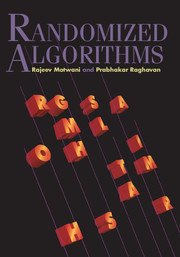Preface
Published online by Cambridge University Press: 05 March 2013
Summary
THE last decade has witnessed a tremendous growth in the area of randomized algorithms. During this period, randomized algorithms went from being a tool in computational number theory to finding widespread application in many types of algorithms. Two benefits of randomization have spearheaded this growth: simplicity and speed. For many applications, a randomized algorithm is the simplest algorithm available, or the fastest, or both.
This book presents the basic concepts in the design and analysis of randomized algorithms at a level accessible to advanced undergraduates and to graduate students. We expect it will also prove to be a reference to professionals wishing to implement such algorithms and to researchers seeking to establish new results in the area.
Organization and Course Information
We assume that the reader has had undergraduate courses in Algorithms and Complexity, and in Probability Theory. The book is organized into two parts. The first part, consisting of seven chapters, presents basic tools from probability theory and probabilistic analysis that are recurrent in algorithmic applications. Applications are given along with each tool to illustrate the tool in concrete settings. The second part of the book also contains seven chapters, each focusing on one area of application of randomized algorithms. The seven areas of application we have selected are: data structures, graph algorithms, geometric algorithms, number theoretic algorithms, counting algorithms, parallel and distributed algorithms, and online algorithms. Naturally, some of the algorithms used for illustration in Part I do fall into one of these seven categories.
Information
- Type
- Chapter
- Information
- Randomized Algorithms , pp. ix - xivPublisher: Cambridge University PressPrint publication year: 1995
Accessibility standard: Unknown
Why this information is here
This section outlines the accessibility features of this content - including support for screen readers, full keyboard navigation and high-contrast display options. This may not be relevant for you.Accessibility Information
- 1
- Cited by
